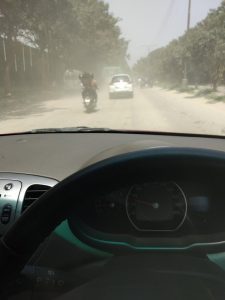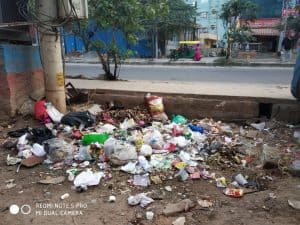Dy CM mulls over temporary ban on private vehicle registration
In an interview with The Economic Times, Deputy Chief Minister G Parameshwara said he is keen on finding solutions to manage the city’s booming vehicular population, especially by ensuring that registration of new vehicles is put on hold for the next two years. His proposal is to stop 2500 private vehicles from being added to the roster everyday, and conversely increase the dependence on public transport. In the meantime, he promised to complete the white topping project within two years to sustain the load of vehicles.
Parameshwara, whose portfolio includes the Bangalore Development and Town Planning department, plans to weed out old vehicles by withholding fitness certificates during the freeze. Post the bye-poll elections, he intends to call a meeting with BBMP, BDA and the transport ministry officials to discuss the matter further.
Experts are not on board with this. Ashish Verma, professor at the civil engineering department of IISc, does not support this idea of temporarily banning new vehicles. He called the move hypocritical on the government’s part as it is building elevated corridors to accommodate the same private vehicles.
Source: The Economic Times | The New Indian Express
Bellandur lake dries up, exposes blackened surface

The aerial view of the Bellandur lake drying. Pic: Whitefield Rising Facebook page
During the last week passers by noticed the infamous Bellandur lake dry up without prior warning, exposing the soot-like blackened surface of the lake-bed. Bangalore Development Authority ( BDA) officials who inspected the water-body concluded that the black matter was only organic mass settled at the bottom over several years.
The receding water level is a cause for concern as the Bellandur lake’s capacity is 14 feet deep according to IISc scientist T.V Ramachandra’s study. The reason has not been determined. BDA engineer BA Shivananda ruled out the possibility of evaporation in such a short span of time. Officials also denied speculations that water supply to the KC Valley project in Kolar was causing the drought, primarily because the quantity transported is not proportional to the amount of water disappearing.
Some residents suspect that the government may have taken some steps leading to the drying up of the lake, so that it does not have to face the scrutiny that it does over the pollution in the water. Others fear it could lead to encroachments on the bank.
Source: The Times of India | Bangalore Mirror | NewsX channel
GIL pays Rs 50 lakh under ‘polluter pays principle’

Dust clouds at Graphite India Junction. Pic: www.reddit.com
Whitefield residents were overjoyed on October 29th when they won the 20- year-old fight against Graphite India Limited’s (GIL) factory for releasing pollutants–graphite dust and soot–close to Whitefield main road. Counsel Shyam Divan appearing for GIL informed the Apex Court that Rs 50 lakh will be paid under the ‘polluter pays principle’ to the Karnataka State Pollution Control Board (KSPCB).
The money has to be deposited in the next two weeks, and is meant to help the board fund measures to curb pollution. The SC took up the case on October 9th as media reports brought the polluting factory to the limelight.
Sunita Narain, member of Environment Pollution Control Authority (EPCA), had informed the court on October 23rd that the factory was not using imported needle coke with lesser sulphur content to manufacture graphite and carbon products. She implied that processing of Indian pet coke variety in the crowded area of Whitefield could be detrimental to the environment.
Her effort was not in vain. The bench headed by Justice Madhan B Lakur, comprised of Justices SA Nazeer and Deepak Gupta, sought an explanation from the defendant. Refusing to fight the court on the issue, senior advocate Divan conveyed to the bench that the entire operations of GIL factory will be shut down by November end.
Earlier this year, KSPCB did not reissue the Consent for Operation ( CFO) certification when it expired on June 30th. GIL had written a plea to the Securities Exchange Board of India (SEBI), addressing all shareholders of the public enterprise in September. The letter said the factory was compliant with environmental laws, pointing out the company had applied for CFO certificate before the expiry period.
Whitefield residents refused to believe the letter as the recent inspection by KSPCB revealed cracked roofs were allowing soot and smoke out of the premises. When the KSPCB tried to shut the plant down in 2012, the Appellate court had reversed the closure order by asking GI to follow norms strictly. Unhappy residents took the case to the National Green Tribunal (NGT), where it was languishing. The SC bench advised residents to continue to pursue the pending litigation at the tribunal.
Source: The New Indian Express | NDTV | The News Minute
BBMP and High Court leave civic issues unresolved

A citizen uploaded this photo one day after BBMP claimed to have cleaned 95% of the garbage. Pic: Whitefield Rising Facebook page
The High Court had given the Palike a strict deadline up to October 31st to make the city garbage-free but another extension was awarded till November 5th. Chief Justice Dinesh Maheshwari instructed the BBMP to make sure the city enjoys a clean Diwali. The civic body claims that 95% of the garbage has been cleared, and only 5% remains to be removed. The issue was first brought to the court’s attention through a PIL filed by Narasimha Murthy and others, when they objected to the storage of garbage next to a temple.
At the meeting of an inter-department coordination committee headed by Chief Secretary TM Vijay Bhaskar, he said that compactors must make a second round before trucks head out to dumping and waste processing sites. Bhaskar also asked the corporation to keep track of black spots where garbage accumulates, and take attendance of auto-tippers regularly. The court said that CCTV cameras can be used to spot miscreants defacing public property much before the police.
The filling of potholes comes with its own challenges and the BBMP explained its setbacks to the HC. While speaking at the recent council meeting, BBMP Commissioner Manjunatha Prasad said that 23,474 roads were dug up by BESCOM, BWSSB and GAIL for various purposes. Prasad said the civic body is developing a scientific way of presenting data on potholes by updating information on its websites. To cover up the potholes easily, two hot mix plants are proposed to be set up by BBMP, which otherwise depends on hot-mix from private players.
Source: Deccan Herald |The Times of India| News18 | The Hindu
No robust mechanism in place to beat air pollution in Bengaluru
The Centre has decided to undertake a domestic study of Indian cities to verify the World Health Organisation (WHO)’s claim that 14 of the world’s most polluted cities are in India. Bengaluru is not on this list, and had comparatively fared better. Nevertheless, area-specific data shows that pollution in the city is a cause for alarm
According to this report, 9 out of 16 air quality monitoring stations in Bengaluru have higher PM 2.5 levels than the prescribed National Ambient Air Quality Standards, which say the acceptable limit is less than 40 micro gram per cubic metre. Central Silk Board Junction showed PM 2.5 levels to be 48% more than the national standards.
The quality of the monitoring systems is also under a cloud. WHO says the city needs 150 air quality monitoring centres, but urban experts say that 41 are enough. At present,the city has 21 stations, of which 7 are functional enough to put out real time data. Previous state budgets have included funding to set up more air quality monitoring stations but that remains etched on paper.
Source: Deccan Herald | India Today | The Times of India
PRR Project back to ground level
The 65-km Peripheral Ring Road project was recently redesigned to provide for elevated corridors, so as to save on land acquisition costs, but now the plan has gone back to building the project at ground level. The change was initiated by urban experts who feel the project lacked focus on developing the area around PRR to reduce congestion. BDA officials are planning to invite bidders to offer consultancy expertise on November 14th. However, the land regulatory body is going to let the final decision be taken by the cabinet.
The new proposal is about developing 1 km on either sides of the 14 lanes part of the PRRs. Modification of rights pertaining to Floor Area Ratio (FAR) and Transfer of Development Rights (TDR) is being considered for ease of land-conversion and ownership. The primary aim still is to cut down land acquisition costs drastically. The government needs Rs 8500 crore for land acquisition, of which Rs 4500 crore is already being funded by the government, while the rest of the funding has to be raised.
Source: The Hindu | The Times of India
(compiled by Seema Prasad)
A year back there was a startup called zip go which offered, group office commute on tempo travlers via mobile app booking but govt banned them saying it’s against the laws, so.my question is why couldn’t they ammed the legislation then, is the Mafia playing hands here
Guys,I’m really confused on how to get started on curbing the dust particles on our Bengaluru roads, I read online the best measures are by Increasing the green coverage and building up footpaths. I’m an electronics engineer myself and I can build devices to measure the dust levels but I just can’t get around to deleting dust from our roads.I live near central silk board junction and it get horrible everyday. If anyone has any idea and are willing to share them please do contact me I’d love to discuss this further.